I’ve dedicated my career to closed-end funds (CEFs) because in a way, these high-yield investments saved my life: Using these funds to get an 8% income stream from my portfolio gave me the confidence I needed to quit my academic job well over a decade ago.
I started writing about CEFs after that, mostly out of surprise and confusion: Why weren’t these reliable income plays—which yield 8.2% on average now—more popular?
Well, after over a decade of talking to economists, bankers, fund managers and other experts, I’ve come to realize they should be more popular, and that they probably would be after a big shock to markets made them irresistible.
That shock came in 2022, a crash that prompted many low-information retail investors to exit the market. They haven’t returned, and are keeping their assets in cash:
Dry-Powder Stockpile Keeps Growing
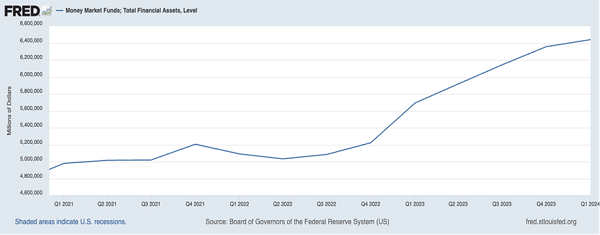
Many of these fearful investors went into money-market funds. Even after the first quarter of 2024, which saw the S&P 500 fully recover, this cash is still on the sidelines.
Some of that money is from cashed-out CEFs. But even so, CEFs’ fundamental asset values have kept rising. That’s driven a recovery in CEF returns, which we can see in this chart, from our CEF Insider Index Tracker, showing the performance of CEFs across sectors, from high-yield and corporate bonds to municipal bonds and equities:
CEFs Move Up, Defying Worrywarts
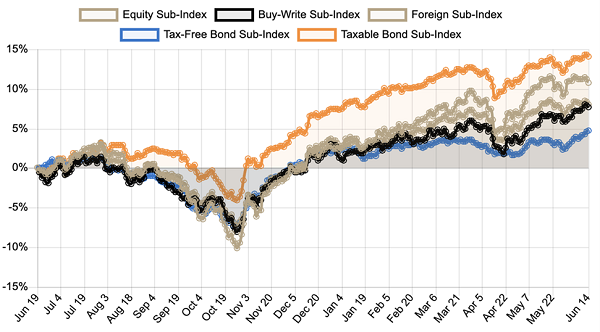
Source: CEF Insider
Even so, retail investors are shying away, mostly due to media-driven fears. In a situation like this, you usually see hedge funds and other activists coming in to take advantage. After all, CEFs’ average discount to net asset value (NAV, or the value of their portfolios) has been about 5% historically, and today it’s lower—around 7%.
However, CEFs were discounted more than 9% a year ago, which prompted activists to move in back then. Now the story is entering a new phase: Discounts are shrinking quickly, as we can see with the PIMCO Dynamic Income Fund (PDI), a well-known (as CEFs go) high-yield-bond CEF that’s a good benchmark for us here.
As I write this, PDI trades at an 11% premium to NAV, after trading at lower premiums and briefly at discounts in 2022, and even as late as mid-2023:
PDI Soars Deep Into Premium Territory
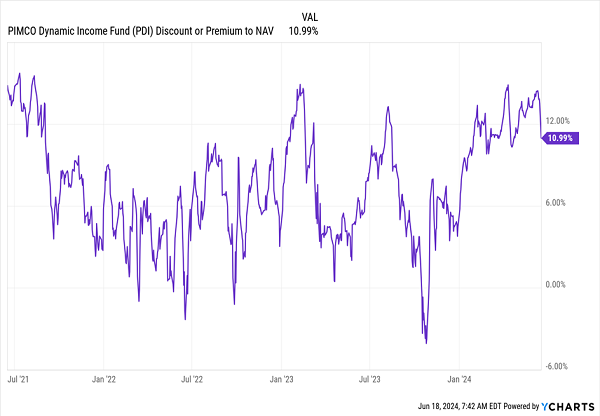
I highlighted this in late 2023, when PDI traded at par (unusual for PIMCO funds, which usually trade at steep premiums). As that par valuation has flipped to a double-digit premium, the fund has delivered a 17.4% return—the kind of gain you usually see from stocks, not bond funds like PDI:
PDI’s Swift, and Profitable, Recovery
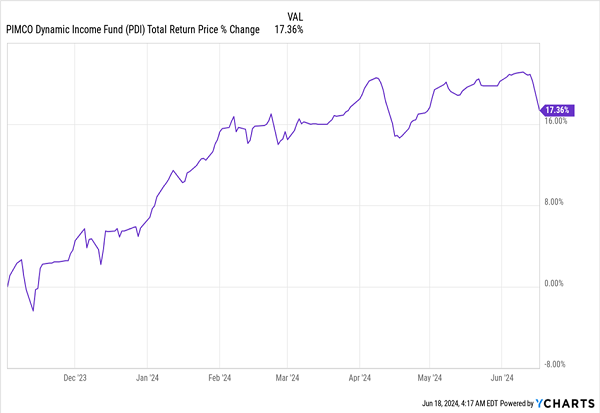
When I first got into CEFs, these kinds of trades were plentiful. But since 2022, they’re harder to find because many good funds remain unusually undervalued. Consider, for example, the discount/premium moves of another CEF, the tech-focused BlackRock Science and Technology Trust (BST).
Lots of Opportunities in This Chart
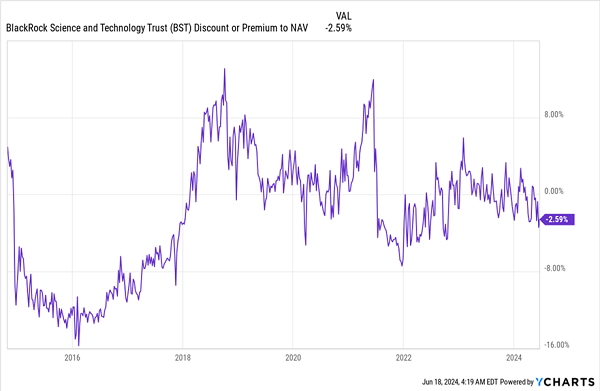
See how BST stayed heavily discounted in the mid-2010s? That was due to worries about the Federal Reserve, inflation and recessions. But BST’s strong performance meant it got a premium valuation by the start of 2018, when tech’s steady rise had gone on for too long for investors to ignore.
Note that there was a dip in demand afterward, due to another rate-driven panic in 2018. Then the pandemic made things worse in 2020, bringing BST to a new equilibrium: trading around par.
Since this equilibrium still exists with a lot of retail investors still shying away from CEFs, there’s room for more premium pricing if they return. And there are signs that this is happening—mainly the fact that average CEF discounts have been rising, as mentioned a second ago.
If BST rises to another 10% premium, investors who buy in today could see roughly 13% capital gains (as of this writing) on top of the fund’s current 7.9% yield.
Discovered: A Rare Shot at CHEAP 8%+ Dividends (We’re Not Going to Miss It)
Right now—with markets gaining but CEFs still trading at big discounts—is the worst -time to be on the sidelines.
Times like these are exactly why most investors underperform the market—or worse, lose money. Instead of buying at a discount and selling when stocks (or in this case CEFs) are dear, they do the opposite: They buy high and sell low!
We’re NOT making that mistake, especially when we’ve got a chance to “lock in” big 8.5%+ dividends from the 5 bargain-priced funds I’m urging all investors to buy now.
Don’t let fear hold you back. Click here to learn why CEFs are off the radar for most people. I’ll also give you a free Special Report naming those 5 cheap CEFs yielding 8.5%+.
Before you make your next trade, you'll want to hear this.
MarketBeat keeps track of Wall Street's top-rated and best performing research analysts and the stocks they recommend to their clients on a daily basis.
Our team has identified the five stocks that top analysts are quietly whispering to their clients to buy now before the broader market catches on... and none of the big name stocks were on the list.
They believe these five stocks are the five best companies for investors to buy now...
See The Five Stocks Here
Nuclear energy stocks are roaring. It's the hottest energy sector of the year. Cameco Corp, Paladin Energy, and BWX Technologies were all up more than 40% in 2024. The biggest market moves could still be ahead of us, and there are seven nuclear energy stocks that could rise much higher in the next several months. To unlock these tickers, enter your email address below.
Get This Free Report